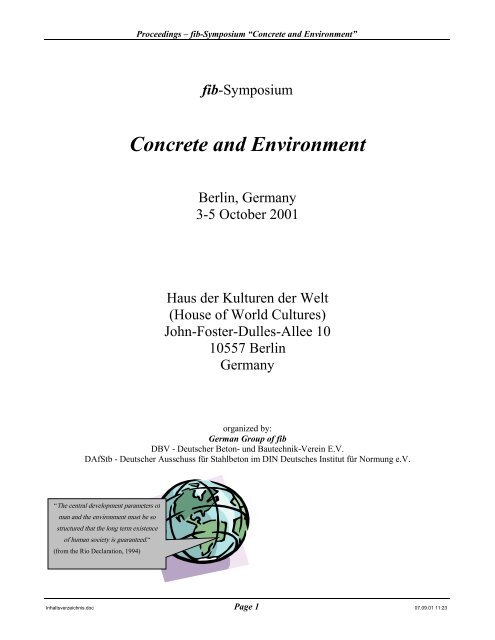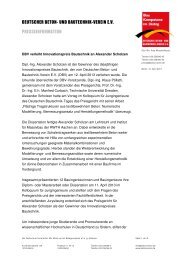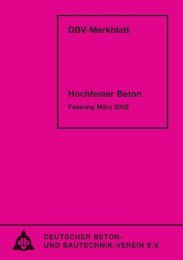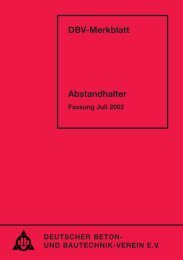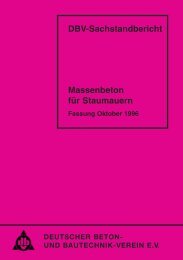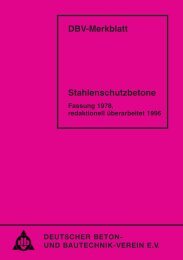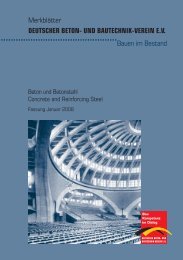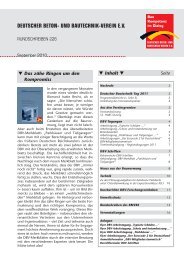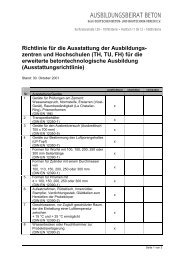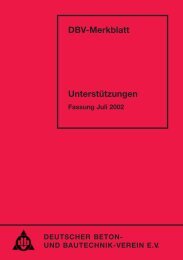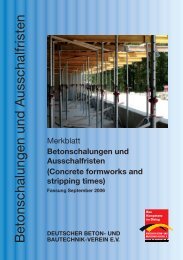Concrete and Environment - Deutscher Beton- und Bautechnik ...
Concrete and Environment - Deutscher Beton- und Bautechnik ...
Concrete and Environment - Deutscher Beton- und Bautechnik ...
You also want an ePaper? Increase the reach of your titles
YUMPU automatically turns print PDFs into web optimized ePapers that Google loves.
Proceedings – fib-Symposium “<strong>Concrete</strong> <strong>and</strong> <strong>Environment</strong>”fib-Symposium<strong>Concrete</strong> <strong>and</strong> <strong>Environment</strong>Berlin, Germany3-5 October 2001Haus der Kulturen der Welt(House of World Cultures)John-Foster-Dulles-Allee 1010557 BerlinGermanyorganized by:German Group of fibDBV - <strong>Deutscher</strong> <strong>Beton</strong>- <strong>und</strong> <strong>Bautechnik</strong>-Verein E.V.DAfStb - <strong>Deutscher</strong> Ausschuss für Stahlbeton im DIN Deutsches Institut für Normung e.V.“The central development parameters ofman <strong>and</strong> the environment must be sostructured that the long term existenceof human society is guaranteed.“(from the Rio Declaration, 1994)Inhaltsverzeichnis.doc Page 1 07.09.01 11:23
Proceedings – fib-Symposium “<strong>Concrete</strong> <strong>and</strong> <strong>Environment</strong>”ContentsForeword – President´s MessageForeword – Organizing Committee of the fib-SymposiumNo.FW1FW2Keynotes A1, A2, B1 <strong>and</strong> B2Session A1: Aesthetical Aspects of <strong>Concrete</strong> StructuresSession B1:Sustainability <strong>and</strong> Life Cycle Analysis (I)Session A2: Protective StructuresSession B2: Sustainability <strong>and</strong> Life Cycle Analysis (II)KNIA1B1A2B2Keynotes A3, A4, A5, B3, B4 <strong>and</strong> B5Session A3 Strengthening, Prolongation of Service Life, Service Life DesignSession B3: Material Aspects of <strong>Concrete</strong> <strong>and</strong> <strong>Environment</strong>Session A4: Prediction <strong>and</strong> Durability (I)Session B4: RecyclingSession A5: Prediction <strong>and</strong> Durability (II)Session B5: Release from Cement bo<strong>und</strong> MaterialsKNIIA3B3A4B4A5B5Keynotes A6 <strong>and</strong> B6Session A6: Energy Conservation, <strong>Environment</strong>al Aspects in Operation,Aspects of Health <strong>and</strong> Working <strong>Environment</strong>Session B6: Practical Construction, Demolition, Demountable StructuresKNIIIA6B6Inhaltsverzeichnis.doc Page 2 07.09.01 11:23
Proceedings – fib-Symposium “<strong>Concrete</strong> <strong>and</strong> <strong>Environment</strong>”ContentsNo.Keynotes A1, A2, B1 <strong>and</strong> B2Approaches to Sustainability in Building Construction Sjöström KN1Establishing Performance Criteria for <strong>Concrete</strong> Protective Structures van Breugel KN2Session A1: Aesthetical Aspects of <strong>Concrete</strong> StructuresBridge Design <strong>and</strong> Urban Development Sigrist, Leuthard A1-1Bright High-Performance <strong>Concrete</strong> by Using Metakaolin Dehn, König A1-2Execution <strong>and</strong> Assessment of Architectural <strong>Concrete</strong> Structures - DesignMeyer A1-3Requirements <strong>and</strong> Limits of TechnologyRealisation of Form <strong>and</strong> Function of a Unique Structure with InnovativeStructural Concepts <strong>and</strong> DesignSession B1: Sustainability <strong>and</strong> Life Cycle Analysis (I)Kanappan, Ramakrishna,RanganathGuide for Sustainable Design Günther, Ornth B1-1Sustainable Pre-Fabrication Punkki B1-2Comprehensive Approach to LCA of Construction Materials <strong>and</strong> Buildings Reinhardt, Kümmel B1-3<strong>Environment</strong>ally based Optimisation of <strong>Concrete</strong> Floor Slabs Hajek B1-4The <strong>Environment</strong>al Effects of Cement <strong>and</strong> <strong>Concrete</strong> within the Concept ofHauer B1-5Sustainable DevelopmentDurability Design <strong>and</strong> Life Cycle Analysis in Reinforced <strong>Concrete</strong> EngineeringSession A2: Protective StructuresKrätzig, Petryna, Pölling,StangenbergA1-4B1-6Application of <strong>Concrete</strong> <strong>and</strong> Reinforced <strong>Concrete</strong> on Construction <strong>and</strong>Transformation “Shelter Object” of the Destroyed Chernobyl NPP Fourth BlockPerformance of <strong>Concrete</strong> Based Building Materials Against Blast <strong>and</strong> ImpactDesign Assistance for Secondary Barriers Produced of Uncoated <strong>Concrete</strong>StructuresProbability of failure <strong>and</strong> risk using a concrete layer as the second barrier towater-endangering fluidsKryvosheyev,.Nemchynov, BamburaGebbeken, Greulich,PietzschA2-1A2-2Brauer, Wiens A2-3Curbach, Proske A2-4Session B2: Sustainability <strong>and</strong> Life Cycle Analysis (II)Comparison of the Ecological Properties of <strong>Concrete</strong>, Steel <strong>and</strong> Timber Lünser B2-1Durability of Resource Saving "Green" Types of <strong>Concrete</strong>Tange Jepsen,Mathiesen, Munch- B2-2Petersen, Bager<strong>Environment</strong>-Friendly “Green” <strong>Concrete</strong> Structures Edvardsen, Tollose B2-3Sustainable Facts for Cement <strong>and</strong> Cement Bo<strong>und</strong>ed Building Products Huber B2-4Grieser, Jacobs,Ecological So<strong>und</strong> Cement Manufacture in Switzerl<strong>and</strong>HunkelerB2-5Inhaltsverzeichnis.doc Page 3 07.09.01 11:23
Proceedings – fib-Symposium “<strong>Concrete</strong> <strong>and</strong> <strong>Environment</strong>”ContentsNo.Keynotes A3, A4, A5, B3, B4 <strong>and</strong> B5<strong>Environment</strong>al Aspects of Construction Materials with Respect to Sustainability Schneider KN3Performance Based Design of Future <strong>Concrete</strong> Structures:The Challenge of Integrating Strength, Durability <strong>and</strong> SustainabilityRostam KN4Session A3: Strengthening, Prolongation of Service Life, Service Life DesignService Life of <strong>Concrete</strong> Offshore Structures Hell<strong>and</strong> A3-1Service Life Prolongation Concepts: How to Watch <strong>and</strong> Listen <strong>Concrete</strong>StructuresStubler, Youdan A3-2Strengthening of <strong>Concrete</strong> Members with Externally Bonded Fibre ReinforcedPolymer ReinforcementMatthys, Taerwe A3-3Method for Increasing Shear Capacity of Old Reinforced <strong>Concrete</strong> Girders Kollegger, Martinz A3-4Opinions on Static Renewal of Precast Panel <strong>Concrete</strong> Buildings Štěpánek A3-5Moerman, Taerwe,Structural Monitoring of a Pre-Stressed <strong>Concrete</strong> Girder Bridge <strong>and</strong> a QuayCoppens, De Waele,Wall with Bragg Grating SensorsDegrieck, Callens, BaetsA3-6Session B3: Material Aspects of <strong>Concrete</strong> <strong>and</strong> <strong>Environment</strong>Use of Granulated Blast Furnace Slag – A Contribution to SustainableDevelopment in Construction IndustryFly Ash Obtained form Co-Combustion - State of the Art in EuropeSimulation of the Corrosion Behaviour of <strong>Concrete</strong> Elements Reinforced withHigh Performance SteelBehavior of Prestressed <strong>Concrete</strong> Beams with Artificial Lightweight AggregateMade from Coal Ashvan den Berg, Vissers,Hohberg, WiensBrühwiler, Denarié,ConciatoriWatanabe, Suzuki,Sakurada, MuraiHärdtl B3-1B3-2B3-3B3-4Session A4: Prediction <strong>and</strong> Durability (I)Prediction of Chloride Ingress into <strong>Concrete</strong> with Additions Wiens, Schiessl A4-1Probabilistic Service Life Design: Application of the DURACRETE-Approachto Existing StructuresGehlen, Schiessl, Pabsch A4-2A study on the applicability of ECC to highway bridge slabsEffects of Curing Conditions on Strength <strong>and</strong> Permeability Properties of<strong>Concrete</strong>s with Various Fly Ash ContentsIchinomiya, Suda,K<strong>and</strong>a, MasumotoAtac, C. Tasdemir,Sonmez, A. TasdemirA4-3A4-4Inhaltsverzeichnis.doc Page 4 07.09.01 11:23
Proceedings – fib-Symposium “<strong>Concrete</strong> <strong>and</strong> <strong>Environment</strong>”ContentsNo.Session B4: RecyclingDesign of <strong>Concrete</strong> Structures Made from Recycled Aggregates – A GlobalRecommendation following the DIN 1045-1Structural RC Members from Recycled Aggregate <strong>Concrete</strong>Zilch, Roos B4-1Ajdukiewicz, Hulimka,KliszczewiczTechnical, <strong>Environment</strong>al <strong>and</strong> Economic Factors Affecting Present <strong>and</strong> FutureVolumes of Recycled Construction Materials in GermanySchmidt B4-3Recycling of Offshore <strong>Concrete</strong> Structures Olsen B4-4Tamura, Noguchi,<strong>Concrete</strong> Design toward Complete RecyclingTomosawa, KitsutakaB4-5Session A5: Prediction <strong>and</strong> Durability (II)Durability of High-Performance <strong>Concrete</strong> <strong>and</strong> Life-Time Prediction Setzer, Palecki A5-1Monteny, De Belie,Simulation of Corrosion in Sewer Systems by Laboratory TestingA5-2Vincke, Beeldens, TaerweHPC – American Practice, European Perspective Bodi, Bruce A5-3Computational Durability Analysis of <strong>Concrete</strong> Structures ConsideringMeschke, Bangert,Damage, Moisture Transport <strong>and</strong> Chemical Dissolution ProcessGrasberger, KuhlA5-4Session B5: Release from Cement bo<strong>und</strong> MaterialsRelease of Inorganic <strong>and</strong> Organic Substances from Cement Bo<strong>und</strong> Materials Spanka, Schneider B5-1The Influence of The Characteristics of Cement Hydration on LeachingHisada, Oguchi, Ooi,Calcium from Hardened MortarNagatakiB5-2<strong>Environment</strong>al Compatibility of Fresh <strong>Concrete</strong> in Contact with Soil <strong>and</strong>Brameshuber, Hohberg,Gro<strong>und</strong> WaterUebachsB5-3Modelling of the Leaching Behaviour of <strong>Concrete</strong> in Contact with Gro<strong>und</strong>WaterHohberg B5-4Leaching of a <strong>Concrete</strong> Superplasticizer from Fresh Cement in Contact with Ruckstuhl, Suter, Kohler,Gro<strong>und</strong>waterGigerB5-5B4-2Inhaltsverzeichnis.doc Page 5 07.09.01 11:23
Proceedings – fib-Symposium “<strong>Concrete</strong> <strong>and</strong> <strong>Environment</strong>”ContentsNo.Keynotes A6 <strong>and</strong> B6<strong>Environment</strong> <strong>and</strong> Energy Behaviour of our Buildings Gertis n.a.Global <strong>Environment</strong>al Issue in Construction IndustryResearch & Development <strong>and</strong> Practice in Japanese Construction IndustryFujimori KN5Session A6: Energy Conservation, <strong>Environment</strong>al Aspects in Operation,Aspects of Health <strong>and</strong> Working <strong>Environment</strong>Imai, Yoshioka, Wu,Adiabatic Curing Cuts Carbon Dioxide <strong>and</strong> Saves EnergyTakahashiA6-1Seasonal Storage of Solar Energy in Hot-Water Tanks made out of HighReineck, Lichtenfels,Performance <strong>Concrete</strong>GreinerA6-2Health- <strong>and</strong> <strong>Environment</strong>-Related Aspects of the Use of Cement Bo<strong>und</strong>Construction ProductsThielen A6-3Improvement of Working <strong>Environment</strong> in <strong>Concrete</strong> Construction by the use ofSelf-Compacting <strong>Concrete</strong>Bartos, Cechura A6-4Self-compacting <strong>Concrete</strong> – Examples of Application Vitek A6-5Practical Experiences with the Application of Self-Compacting <strong>Concrete</strong> inGermanyBrameshuber, Uebachs A6-6Application of Photocatalysis to Develop Pollutant Degrading <strong>and</strong> Self-cleaningBuilding MaterialsBenedix, Dehn, Quaas A6-7Session B6: Practical Construction, Demolition, Demountable StructuresHishiki, Ichinomiya,Experimental Study on Seismic Performances of Precast Segmental PC PierAraiB6-1Potsdamer Platz Berlin – <strong>Environment</strong>al Aspects During Construction Falkner B6-2Gerlach, Eibl,Removal of Gypsum Plaster by the Use of MicrowavesStempniewskiB6-3A Complete Testing Including Earthquake Behaviour of a Demountable<strong>Concrete</strong> StructurePopaescu, Praun, Schiau B6-4Condition Assessment of <strong>Concrete</strong> Bridges During Demolition Vogel B6-5Design for Disassembly – Approach towards Sustainable Building Graubner, Reiche B6-6Inhaltsverzeichnis.doc Page 6 07.09.01 11:23
Proceedings – fib-Symposium “<strong>Concrete</strong> <strong>and</strong> <strong>Environment</strong>”Foreword – President´s Message“<strong>Concrete</strong> <strong>and</strong> the environment” is on its way to become one of the major topics in practical design <strong>and</strong>construction. During the last decade’s research on concrete <strong>and</strong> concrete structures has mainly focused onaspects like safety <strong>and</strong> serviceability. The consciousness of the significance of durability <strong>and</strong> sustainability isstill relatively young. However, it is now already a common feeling that those aspects must play a crucial role inthe near future. This new way of thinking will have important consequences for the direction in which designstrategies will develop. The same holds true for the process of execution <strong>and</strong> the developments of contractualregulations, code requirements <strong>and</strong> research.fib is an international organization with National Groups in 39 countries <strong>and</strong> members or participants in its workfrom about 60 countries. Its main goal is to stimulate <strong>and</strong> coordinate future-oriented research <strong>and</strong> to givedirection to the development of new building codes. In the past CEB <strong>and</strong> FIP, the organizations, which precededfib, published “Model Codes” for Structural <strong>Concrete</strong> in 1963, 1978 <strong>and</strong> 1990. Those Model Codes wereintended to be a source of information for the development of national <strong>and</strong> international codes. The Model Code1990 has been an important basis for the new Eurocode, which is bo<strong>und</strong> to be the code used throughout Europe,as such stimulating <strong>and</strong> strengthening the international cooperation.The interest of CEB <strong>and</strong> FIP in durability in the past was mainly directed to durability in the sense of expectedlifetime. The way in which deterioration processes endanger the life of a structure was well described in CEBBulletin 183 “Durable <strong>Concrete</strong> Structures”. This Bulletin was the onset to the development of the new approach“Design for Durability”. The conceptual work leading to this new approach was mainly done within the scope ofthe European research program “Duracrete”. The design strategy developed enables predicting the forthcomingneed for repair, to select the most appropriate maintenance strategy <strong>and</strong> to allow cost optimization calculationsfor concrete structures with due regard to their lifetime. It furthermore gives impetus to the introduction ofdefined performance concrete’s, taylor-made for the governing environmental conditions. fib is now starting itswork for a new Model Code for <strong>Concrete</strong> Structures. Design for durability will be a major point of attention.Studies in this area are now performed in fib-Commission 5 <strong>und</strong>er the chairmanship of Dr. Steen Rostam fromDenmark.However, in spite of its significance, “durability” as a thematic indication is still too narrow. In order to save ourenvironment from unnecessary burdens now <strong>and</strong> in the future <strong>and</strong> to improve the quality of life, suitablestrategies have to be developed. This covers a wide area, from the development of clean production methods tothe generation of structural systems, which can be adapted to changing dem<strong>and</strong>s in time, methods for theoptimum use of resources, <strong>and</strong> new concepts for concrete structures protecting the environment. Such subjectsare studied in fib-Commission 3, <strong>und</strong>er the chairmanship of Prof. Peter Schiessl from Germany. These relativelynew areas are of utmost importance for a responsible use of concrete in the near future.In the area of durability <strong>and</strong> sustainability considerable work is still necessary in order to develop new ideas <strong>and</strong>methods, <strong>and</strong> establish regulations. Therefore this symposium has been organized exactly at the right time. Thepapers in the proceedings cover various areas of importance, give a good idea of the state of the art <strong>and</strong> showperspectives to new ideas <strong>and</strong> developments. We are indebted to our German colleagues for their initiative toorganize this symposium <strong>and</strong> the efforts they have done to make it a major event. We sincerely hope that thissymposium will be a milestone in a very important new process of development.Joost WalravenPresident of fibInhaltsverzeichnis.doc Page 7 07.09.01 11:23
Proceedings – fib-Symposium “<strong>Concrete</strong> <strong>and</strong> <strong>Environment</strong>”Foreword – Organizing Committee of the fib-Symposium<strong>Environment</strong>al aspects or, in other words, sustainable development have become a major concern of our time.The general principle of sustainable development has been first formulated by the Br<strong>und</strong>tl<strong>and</strong> Commission in1987. Due to the adoption of the Agenda 21 in Rio de Janeiro by 179 Nations in June 1992, the course forsustainable development was set. As a result of that a gradual change in the f<strong>und</strong>amental social <strong>and</strong> economicvalues will take place. Sustainable development means the satisfaction of the present-day needs without riskingthat future generations will not have the chance to satisfy their needs.National legislation has taken place in several countries following these principles, thereby strongly influencingtechnical rules. This development will have a major impact on all activities related to design <strong>and</strong> construction inthe future.Therefore, the fib-Symposium “<strong>Concrete</strong> <strong>and</strong> <strong>Environment</strong>” will deal with these aspects <strong>and</strong> highlight thefollowing main subjects:· Impact of concrete structures on man <strong>and</strong> environment,· influence of environment on the service life of concrete structures,· ability of concrete structures to protect man <strong>and</strong> environment against hazards.The symposium with its highly relevant programme will offer an international forum for engineers active inpractice or research, politicians, architects, consultants <strong>and</strong> contractors.Peter SchiesslLars MeyerHans-Ulrich LitznerUdo WiensOrganizing Committee of the fib-SymposiumInhaltsverzeichnis.doc Page 8 07.09.01 11:23


